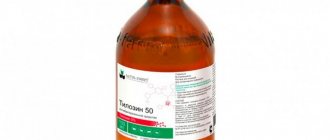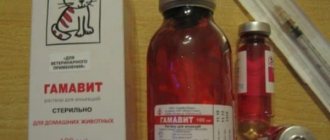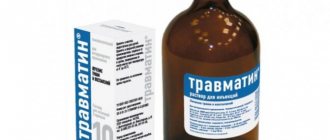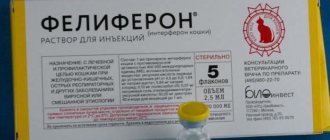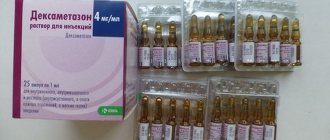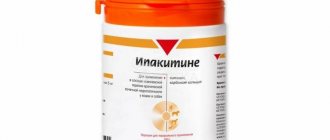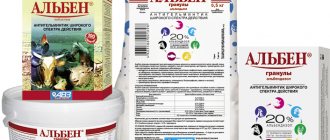The drug Tylosin 50, 200 is a drug from the group of antibiotics that is used in veterinary medicine to treat pulmonary infections of animals and other infectious diseases of various organs. It was included in the veterinary directory in 2013, and since then has been widely used in the treatment of cattle, pigs, birds and domestic animals. The drug contains 50 mg of tylosin, is available in the form of a solution for intramuscular injection, has a viscous consistency and a yellow tint.
Additional substances of the drug Tylosin 50 are benzyl alcohol, water and propanediol. Glass bottles with medicine are sealed with a stopper and closed with aluminum caps.
Biological properties and action
Among the pharmacological properties of the veterinary drug are:
- antibacterial effect – Tylosin is a macrolide antibiotic, has a pronounced antibacterial effect, extending to animals of several species;
- acts on gram-positive and gram-negative bacteria, including streptococci and staphylococci, which cause pneumonia in animals;
- inhibits protein synthesis of pathological microorganisms;
- intramuscular administration ensures rapid penetration of the drug into the body, its maximum concentration in tissues is observed an hour after injection;
- the therapeutic effect lasts throughout the day, is excreted from the animal’s body along with milk (in cows, goats), but mainly with urine and bile;
- This is a low-toxic substance, which is why Tylosin 50 has become popular in veterinary medicine.
The drug Tylosin 50 can equally effectively cope with infections of cattle, birds, cats, dogs and other animals .
Any pathology of bacterial etiology may become an indication for the use of this drug. The instructions contain information on methods of treating certain types of animals.
Mechanism of action of the drug
Tylosin belongs to the group of macrolides. Tylosin implements its mechanism of action by binding to the ribosomes of bacterial cells and blocking protein synthesis with them, due to which the bacteria lose the ability to reproduce and also restore their structure, as a result of which they die. Since Tylosin does not directly destroy bacteria, its action is defined as bacteriostatic.
Tylosin is active against:
- streptococcal flora;
- staphylococcal flora;
- anthrax bacilli (cats are not susceptible to this infection);
- causative agent of pasteurellosis;
- Haemophilus influenzae;
- Leptospira;
- chlamydia;
- spirochete;
- coli;
- some other microorganisms.
The action of Tylosin develops quickly; when administered intramuscularly, its concentration becomes therapeutic within 60 minutes.
Tylosin is available in a wide range of volumes and dosages, which makes use convenient
Tylosin reaches its greatest accumulation in:
- kidneys;
- bronchi and lungs;
- mammary glands;
- liver tissues;
- intestines.
Tylosin is removed by:
- kidneys - excreted in urine;
- liver - through bile;
- if a cat is nursing kittens, Tylosin will also be found in breast milk.
When assessing the degree of impact on the body, Tylosin, like all macrolides, is recognized as a low-hazard compound.
Tylosin 50 – instructions
The antibiotic Tylosin in veterinary medicine is administered exclusively intramuscularly . It should be used once a day. The dosage differs depending on the weight and type of animal. Each injection of the drug is carried out in a different place in order to avoid hematoma and infection.
Types of animal and dosage of Tylosin 50 per 1 kg of body weight:
- pigs – 0.2–0.05;
- cattle – 0.1–0.2;
- cats and dogs – 0.005–0.2;
- sheep and goats – 0.05–0.2.
When using the drug on your own without a veterinarian, you need to administer the minimum permissible dose. If the body reacts negatively to the drug, it must be discontinued and a veterinarian should be called. Most possible adverse reactions go away on their own without outside help.
Composition and release form of the drug
Tylosin is a broad-spectrum antibacterial drug. The active ingredient is tylosin. The drug "Tylosin 50" contains 50 mg of the active ingredient in 1 ml of the drug. The auxiliary components are:
- benzyl alcohol;
- propanediol;
- purified water.
The drug is produced in the form of a liquid injection. The medicine has a light yellow tint. It is completely transparent, the consistency is viscous. Tylosin is available in several dosages:
- 20 ml;
- 50 ml;
- 100 ml.
Depending on the manufacturer, the bottle for the drug is made of transparent light or darkened glass. To ensure tightness, the vial is closed with a rubber stopper, which is secured on top with an aluminum cap.
Indications in veterinary medicine
The use of the drug for cattle, cats and dogs is indicated in the following cases:
- respiratory tract infections, bacterial pneumonia;
- arthritis and other inflammatory processes of joints and bone tissue;
- secondary infection of the animal;
- mastitis in cattle;
- atrophic rhinitis in pigs;
- dysentery, intestinal disorders;
- enzootic pneumonia.
Tylosin 50 is suitable for the treatment of any pathologies of viral origin in the case where the pathological microorganisms are sensitive to the main component of the drug - tylosin.
III. Pharmacological properties
9. Tylosin 50 and Tylosin 200 belong to the macrolide group of antibacterial drugs. 10. Tylosin is active against gram-positive and some gram-negative bacteria, including: E. coli., Bacillus anthracis, Pasteurella spp., Haemophilus spp., Leptospira spp., Staphylococcus spp., Streptococcus spp., Erysipelothrix spp., Corynebacterium spp., Mycoplasma spp., Chlamydia spp., Treponema spp. (Brachyspira). Tylosin has a bacteriostatic effect, inhibiting protein synthesis in bacterial cells as a result of the formation of a complex by the 50S ribosomal subunit. When administered intramuscularly, the antibiotic is rapidly resorbed and reaches maximum tissue concentrations approximately 1 hour after administration. The therapeutic level of the antibiotic in the body is maintained for 20 to 24 hours. It is excreted from the body mainly with urine and bile, and in lactating animals – with milk. According to the degree of impact on the body, it is classified as a low-hazard substance (hazard class 4 according to GOST 12.1.007-76).
Application benefits
This antibiotic is very popular in veterinary medicine for the treatment of cats, dogs, cattle, pigs and birds. This is due to its wide action, ease of use, and low cost. It has proven itself in the treatment of pneumonia.
The use of Tylosin 50 has the following advantages:
- the drug is stable and equally effective in treating animals of different species;
- this is one of the few safe antibiotics in veterinary medicine;
- favorable cost of the drug;
- rapid elimination from the body, slaughter of animals is possible after 8 days.
The medicine is administered over the course of a week, one injection daily; it is not advisable to interrupt the course .
If you miss one day of administration, the next day you do not need to increase the dosage, but continue to follow the regimen indicated in the instructions.
Antibiotics from the macrolide group
This type of drug has a complex cyclic structure. The principle of their action is to block bacterial protein synthesis. As a result, the pathogen loses its ability to grow and reproduce. One of the main distinguishing features of drugs in this group is their relative safety for the body and the possibility of long-term use. All this fully applies to the drug Tylosin. This drug is active against some gram-negative bacteria and most gram-positive ones.
Scientists conducted studies on the long-term use of the drug Tylosin in doses three times higher than therapeutic doses on calves, lambs and piglets. As a result, it was revealed that it does not have a negative effect on the body of animals even in such quantities. The composition of the blood in the experimental subjects remained the same as it was before using the drug (except for the increase in hemoglobin levels). During the research, among other things, the weight of the animals even increased.
Contraindications and side effects
Contraindications to the use of Tylosin 50 include an allergic reaction , intolerance to individual components of the drug, and rash.
In pigs, skin irritation may occur, swelling may occur, and in rare cases, the animal's rectum may prolapse. Respiratory adverse reactions and dermatological lesions disappear without a trace after discontinuation of the drug. Signs of overdose have not been established. It is not recommended to administer Tylosin 50 together with other antibiotics, chloramphenicol, penicillin. Slaughter of cattle and pigs for meat is allowed within 8 days from the date of the last administration of the antibiotic. Forcibly killed animals before the expiration of the required period are unfit for human consumption; the meat can be used to feed other animals.
In what cases is the use of the drug unacceptable?
The instructions for use indicate that the drug is well tolerated by animals. It is approved for use in the treatment of kittens, castrated cats and aging cats. However, when used together with another antibiotic, the risk of adverse reactions increases, and the effect of Tylosin is reduced or completely blocked by other drugs. It is unacceptable to inject an antibiotic together with the following types of drugs:
- penicillins (Amoxicillin, Ampicillin, Oxacillin);
- cephalosporins (Ceftriaxone, Cefuroxime, Cefpirome);
- lincosamides (Lincomycin, Clindamycin);
- tiamulin;
- chloramphenicol.
Absolute contraindications also include an allergic reaction to one of the components of the drug and the appearance of negative symptoms when using the drug in the past. Relative contraindications are liver and kidney diseases. If pathology is present, the veterinarian weighs the possible harm and benefits of using Tylosin.
If it is necessary to take an antibiotic, the possibility of parallel maintenance therapy is considered. It is unacceptable to use a drug that has expired and has signs of spoilage:
- turbidity;
- darkening of color;
- sediment formation;
- the appearance of an uncharacteristic odor.
Precautionary measures
When working with any veterinary drug, you need to worry about personal safety so that the drug does not accidentally enter the circulatory system. Working with animals requires skill as you have to hold them while choosing the right injection site. Given their desire to escape and their strength, the risk of accidentally piercing their skin with a needle increases. Before the injury occurs, the needle may no longer be sterile, which can lead to serious infection.
When working with Tylosin 50 you should wear gloves ; if the drug comes into contact with mucous membranes or skin, it should be washed immediately. During the injection, your hands should be free; smoking, drinking alcohol and eating food are prohibited during this time. After the procedure, hands should be washed with soap, disinfected and wiped dry.
Reviews from dog breeders
Dmitry, Korolev. My schnauzer has had stomach problems since childhood. We thought it was nothing serious, and suddenly the diagnosis was chronic gastritis. During exacerbations, the dog suffers terribly, it is scary to give painkillers, it can provoke internal bleeding. The doctor prescribed antibiotics, decided to find out more about them, and looked through a bunch of websites. It turned out that Tylosin is very effective for gastritis in dogs, and it was prescribed to us. We took 7 injections and the symptoms disappeared. It’s been six months now without attacks and no side effects. If anything happens, we'll inject it again, it seems harmless.
Svetlana, Yekaterinburg. I have come across antibiotics more than once, since I have 3 dogs. The usual reaction is diarrhea and a long recovery of intestinal microflora. The latest experience was the treatment of mycoplasmosis in dogs with Tylosin (2 animals were affected at once). Surprisingly, there was no negativity, there was no diarrhea, and there was no refusal to eat. In general, the dogs tolerated the injections very easily; they needed 3 of them per course. I studied the instructions for the medicine, it is possible that I will use it in other difficult cases. Still, finding a drug that animals will tolerate without consequences is not so easy; I don’t want to experiment on my pets.
Olga, Svetlogorsk. Our lapdog is already old and has been suffering from periodically worsening arthrosis for several years. We treat inflamed joints with Tylosin. A couple of injections are enough and the dog feels much better. I didn’t notice any side effects; it’s convenient that the drug has an analgesic effect.
Tylosin is a bacteriostatic antibiotic developed specifically for dogs and has no analogues in the human world.
It acts on some gram-negative and all gram-positive bacteria, such as:
- staphylococci,
- streptococci,
- Leptospira,
- clostridia,
- corynebacteria,
- erysipelothrix,
- chlamydia,
- pasteurellas,
- spirochetes,
- Treponema chiodysentery and mycoplasma.
Tylosin is derived from several strains of actinomycetes that were isolated from soil in Thailand. It is used to treat canine diseases such as bronchopneumonia and various secondary infections due to viral diseases.
special instructions
The drug Tylosin should be stored in a closed bottle , in a dry place where sunlight does not penetrate. The optimal temperature is +10–25 degrees. The shelf life of the antibiotic is 2 years; after opening the medicine, it must be used within 30 days, after which it becomes unsuitable for treatment.
Animal milk can be consumed 4 days after the last injection . Milk obtained earlier can be given to other animals; humans are prohibited from consuming it. Used packages of the drug cannot be stored at home and used for domestic purposes. All bottles are disposed of, as is unused medication after the expiration date.
Side effects
There are no obvious side effects. In some cases, individual intolerance is possible, manifested in the form of edema, lethargy, increased body temperature of the bird, loss of appetite and refusal to drink. The listed negative consequences of taking the drug disappear some time after removing it from the bird’s diet.
When performing a subcutaneous injection with fish oil, a small rash may appear at the site where the needle is inserted. To avoid this, it is necessary to use only a water or milk base for preparing the drug. When tylosin is administered into the sinuses, a temporary deterioration in the bird’s well-being is possible, manifested in the form of general lethargy and lack of interest in what is happening.
